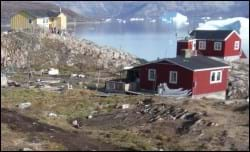Qeqertaq is the second largest settlement belonging to Ilulissat and is located approximately 90 km north of Ilulissat. Qeqertaq means “the island”; A name that refers to the location of the settlement on an island in Tasiusaq Bay. The settlement became a trading station in 1845, and today it is a typical Greenlandic fishing, sealing and whaling community. The settlement splits into two, with the 'lower' part near the port and to the east and the ‘upper’ part to the west. Links to the neighbouring settlement Saqqaq are close.

Provisions and subareas
The general provisions apply to all subareas of the municipalities in towns, settlements and open country areas. The provisions are general and do not consider the local conditions in the subareas.
General provisions of the Town Plan
The overall provisions for each subarea are the basis for the municipality"s granting of area allotments and building permits.
At a minimum, the present service level and housing supply in Qeqertaq are to be sustained. There is a particular need to develop and strengthen the fishing and processing industries through zoning areas that can accommodate a diversified fish processing industry. The tourism industry may be developed jointly with the neighbouring settlement Saqqaq. Housing conditions and community facilities are to be improved to prevent outward migration. In addition, the physical (indoor and outdoor) settings are to be able to accommodate the activities of associations and provide a good meeting place for people.
Qeqertaq's current population counts 108 people in 2017.. Population increased significantly from 1977 to 2006, but has declined since then. In the future, it is expected that the population will stagnate. Against this background, replacement buildings are the main requirement of the present planning period.
All houses in Qeqertaq are detached, 1½-storey single-family houses. Some houses are in need of repair.
In the town plan, the remaining capacity in Qeqertaq is estimated to approximately 20 homes.
The primary trade in the settlement is fishing for Greenland halibut. The fish is handled as trading fish and processed at the processing plant of Qeqertaq Fish, which was taken over by Royal Greenland in 2013. Previously, a variety of fish and shark etc. was caught and traded in the settlement. The settlement is frequented by tourists on boat trips from Ilulissat.
Naalakkersuisut has designated the areas next to the two docks as a port authority area, including the outermost piece of the isthmuses.
Jobs in the settlement are mainly tied to the fishing industry, but also to a lesser extent to the tourism and service industry, the shop, the school and municipal services. Overall, the employment rate has declined in the settlements of Ilulissat since 2010. The four settlements in the Ilulissat district had a total unemployment rate of 6.7% in 2015, which is lower than for Ilulissat (7.7%). Both Ilulissat and Uummannaq municipalities have a total unemployment rate of 6.7%, which is Avannaata Kommunia's lowest, and thus also slightly lower than the municipal average (9.1%). The unemployment rate in the settlements of the Ilulissat district is also somewhat lower than the national average (9.1%).
In the town plan, the remaining capacity for industry and port facilitiesin Qeqertaq is estimated to approximately 1,000 m².
Qeqertaq has a heliport approximately 500 metres north of the settlement. All other transport is by boat. The settlement is served by Diskoline calling at the settlement weekly. Roads in the settlement consist of a system of paths stretching from the dump in the north to the port in the south. Waste and night soil are deposited at the dump. The incineration plant in the settlement is out of order, but the dump causes no nuisance to the settlement.
Nukissiorfiit handles overall technical operations in the settlement. Water is supplied from desalination plants and is led to a bottling house in the settlement. Houses are heated by independent oil-fired boilers. There are no sewerage facilities in the settlement. Power is supplied by a diesel-powered power plant. Tank installations are located at the tip of the port and are surrounded by a safety zone.
TELE Greenland A/S handles telecommunications.
The settlement has a school (Iisaap Atuarfia). The school covers the entire period of compulsory education and has approximately 16 pupils. In addition, there are a nursing station, a community workshop and an all-purpose shop (KNI shop). Family day care is the only childcare option.
The oldest buildings in the settlement are located in the port area near the old trading area. The preservation-worthy buildings are a warehouse from 1945 (B-40) and a coal house from 1893 (B-43). The buildings are no longer used. Qeqertaq has a relatively new church, which was built in 1992. The cemetery is located to the west of the settlement and is in good repair.
Local cultural and leisure activities are concentrated in the school and the village hall. The surrounding nature and the sea offer ample opportunities for leisure and outdoors activities.




